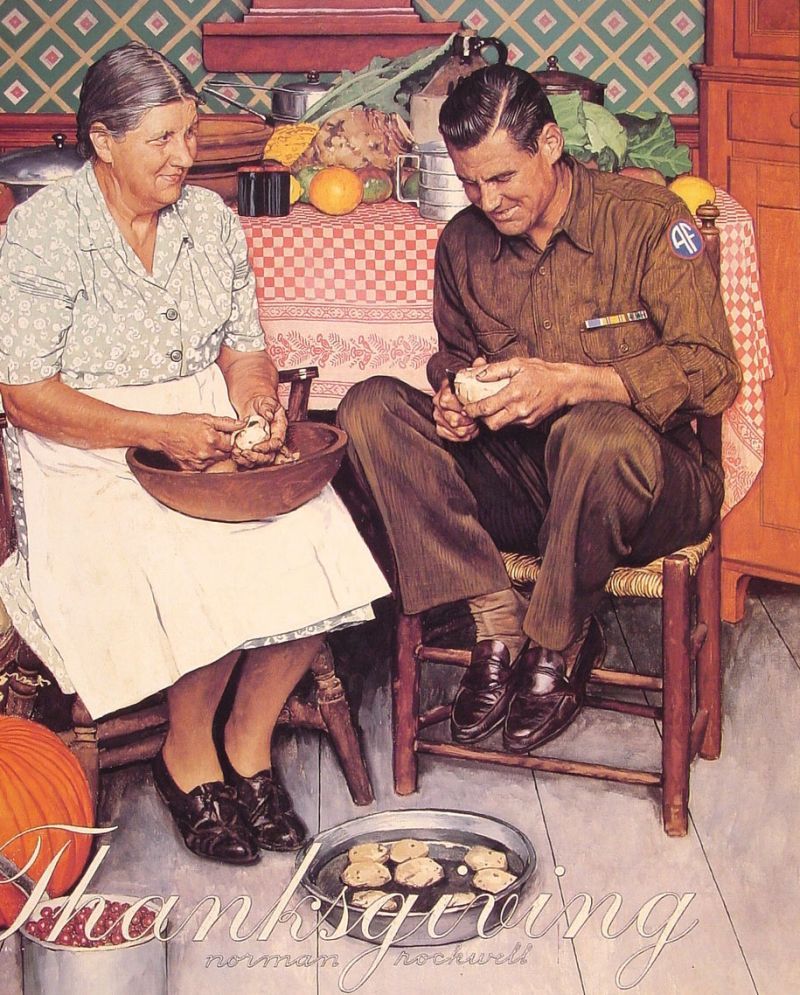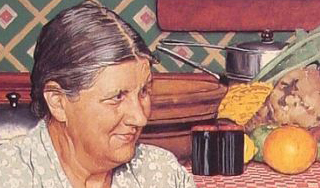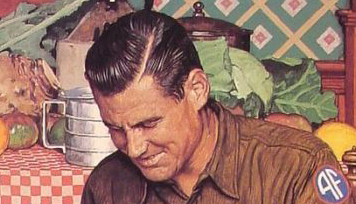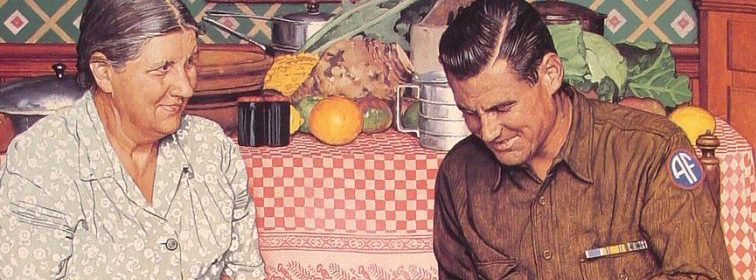Today in the humanities class I’m teaching with my sister, we discussed “Delight.” If I had to choose a single artist who best depicted the combined feelings of joy, peace, and love in a single moment, it would almost certainly be Norman Rockwell. He’s well-known for his ability to depict variations of joy and happiness, and there are lots of paintings to choose from. But out of all his works, I decided that this somehow fit the theme of “Delight.” I liked the idea of simplicity, the sense of warmth, and of course the upcoming feast. It seemed so straight-forward and “easy.” But after looking at it and discussing it in class, I kept on thinking about it and I slowly unpacked why this image specifically seemed to resonate with me and my own perception of delight.

Unlike other Rockwell pieces, this wasn’t just a “some” cover with random hired models: the man in this painting is Dick Hagelberg, and his real-life mother Saara (Finnish spelling.) Rockwell originally conceptualized the painting with a young soldier returning home, but he decided he wanted a model who was older, someone who had experienced the hardships of war. Hagelberg (in addition to being Rockwell’s neighbor) was a pilot in the 9th Army Air Corps, flying 65 dangerous daylight bombings missions over Europe (including D-Day) and fit Rockwell’s idea perfectly.
What makes Rockwell such a timeless artist is not his ability to invent a narrative, but in his ability to select one that his viewers have already felt in their own hearts. Rockwell did not invent the mother-son relationship between these two figures, but he knew the universal nature of that relationship, AND he knew the impact that relationship would have on the readers of the Post, especially during World War II. He leaves no doubt as to the emotional intent of the painting, just as we no doubt about the authenticity of that emotion. We see the delight in the image, and we truly feel the delight in our hearts.

We might see this moment the way the mother must see it: we see youthful boyishness in the man’s pose, the impact of the uniform softened by rolled sleeves, and for a moment, we stop in our monotonous task to simply appreciate that we are sharing that task with a loved one.

Or perhaps we see it as the man must see it: a menial task become a simple pleasure, a place once departed becomes a haven, and we feel at peace knowing that we are under the eyes of one who loves us dearly.
But this is not a young mother or a young son: we aren’t just seeing one Thanksgiving, but also the memory of so many Thanksgivings gone by. This is not just one homecoming, but one of several. This is not the excitement of childlike anticipation of some surprise, but rather the contentment of familiar delight. A man who has risked his life has returned home to sit next to his mother, and together they prepare a meal, as they have done many times. We can see by the joyful serenity in their faces that they have learned the importance of such moments: they are living and embracing the experience in all its simplicity and predictability.
I’ll also share a quote from Chesteron (“Orthodoxy”) that my sister referenced in our class:
[Children] always say, “Do it again”; and the grown-up person does it again until he is nearly dead. For grown-up people are not strong enough to exult in monotony. But perhaps God is strong enough to exult in monotony. It is possible that God says every morning, “Do it again” to the sun; and every evening, “Do it again” to the moon.
This painting speaks volumes about the ability to “exult in monotony.” Both mother and son would gladly say “Do it again” after the moment has passed.
I think that’s why this painting is affecting me so deeply. It’s tempting for me to try and find new, exciting sources of happiness, or to wish for miraculous remedies to my frustrations and struggles. I daydream about lottery-like solutions that I’m certain are necessary for lifting all of my burdens. But is delight really so out of reach? Maybe it’s closer than we think. In fact, maybe we’ve already experienced profound delight, and we actually have the means of experiencing it again.
It’s not that “new” joys are better or worse. The excitement of a new place is unlike the nostalgia of a familiar road. The thrill of a new activity is different from the mastery of something done often. But our desire for what is “new” often overshadows the accessibility of the common. Sometimes we can just say “Do it again.” Sometimes another sunrise is all our hearts really need.
Sometimes, in the midst of uncertainty, fear, and suffering, delight can be as simple as peeling a potato.

This post is a bit different from what I typically write, but honestly, this painting has been on my mind and heart all morning. I got a bit teary at multiple points, so I’m definitely not objective enough to know if it even makes sense. But I really wanted to write this all out and it’s my blog, soooooooo I did! I hope you enjoyed it!

Mary! This made me cry multiple times. Where is this class you’re teaching? I want to take it. I heart this painting, and ORTHODOXY, and your beautiful writing about both.
Also, did you see how with his legs up on the rung of the chair, he looks like a little boy? Another way you can see all the times they’ve done this before…
Yes! I noticed that, and I was really thrilled when one of kids in our class noticed it before I could point it out.
It’s just for a small home-school co-op that my sister’s kids are in! She’s technically the teacher and I’m the assistant teacher. We basically used various emotions as “themes” and talked about how each emotion is portrayed in literature and art. It’s a tiny class of four teenagers, but it’s a wonderful experience!
That class sounds awesome in every way!